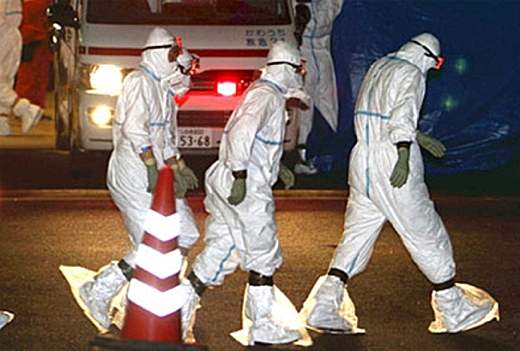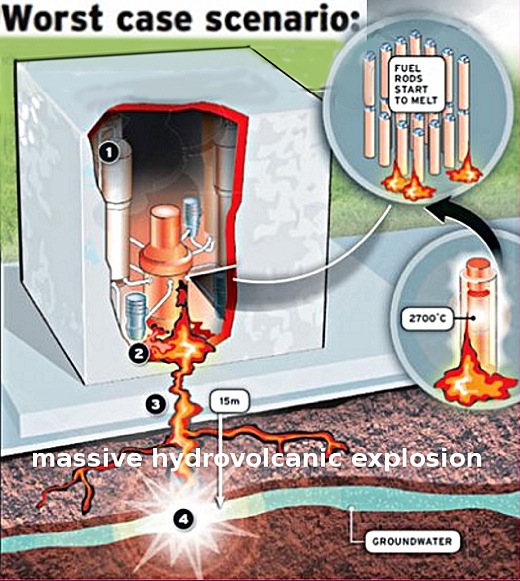By Robert Irvine on 16 December 2011 for Mainichi Daily News -
(http://mdn.mainichi.jp/mdnnews/news/20111216p2a00m0na002000c.html)

Image above: Tepco contract workers enter Fukushima nuclear plant to work with plastic bags taped over footwear. From (http://www.tokyoprogressive.org/content/dying-tepco-fukushima%E2%80%99s-nuclear-contract-workers-genpatsu-gypsies).
Conditions at the Fukushima No. 1 nuclear plant are far worse than its operator or the government has admitted, according to freelance journalist Tomohiko Suzuki, who spent more than a month working undercover at the power station.
"Absolutely no progress is being made" towards the final resolution of the crisis, Suzuki told reporters at a Foreign Correspondents' Club of Japan news conference on Dec. 15. Suzuki, 55, worked for a Toshiba Corp. subsidiary as a general laborer there from July 13 to Aug. 22, documenting sloppy repair work, companies including plant operator Tokyo Electric Power Co. (TEPCO) playing fast and loose with their workers' radiation doses, and a marked concern for appearances over the safety of employees or the public.
For example, the no-entry zones around the plant -- the 20-kilometer radius exclusion zone and the extension covering most of the village of Iitate and other municipalities -- have more to do with convenience that actual safety, Suzuki says.
"(Nuclear) technology experts I've spoken to say that there are people living in areas where no one should be. It's almost as though they're living inside a nuclear plant," says Suzuki. Based on this and his own radiation readings, he believes the 80-kilometer-radius evacuation advisory issued by the United States government after the meltdowns was "about right," adding that the government probably decided on the current no-go zones to avoid the immense task of evacuating larger cities like Iwaki and Fukushima.
The situation at the plant itself is no better, where he says much of the work is simply "for show," fraught with corporate jealousies and secretiveness and "completely different" from the "all-Japan" cooperative effort being presented by the government.
"Reactor makers Toshiba and Hitachi (brought in to help resolve the crisis) each have their own technology, and they don't talk to each other. Toshiba doesn't tell Hitachi what it's doing, and Hitachi doesn't tell Toshiba what it's doing."
Meanwhile, despite there being no concrete data on the state of the reactor cores, claims by the government and TEPCO that the disaster is under control and that the reactors are on-schedule for a cold shutdown by the year's end have promoted a breakneck work schedule, leading to shoddy repairs and habitual disregard for worker safety, he said.
"Working at Fukushima is equivalent to being given an order to die," Suzuki quoted one nuclear-related company source as saying. He says plant workers regularly manipulate their radiation readings by reversing their dosimeters or putting them in their socks, giving them an extra 10 to 30 minutes on-site before they reach their daily dosage limit. In extreme cases, Suzuki said, workers even leave the radiation meters in their dormitories.
According to Suzuki, TEPCO and the subcontractors at the plant never explicitly tell the workers to take these measures. Instead the workers are simply assigned projects that would be impossible to complete on time without manipulating the dosage numbers, and whether through a sense of duty or fear of being fired, the workers never complain.
Furthermore, the daily radiation screenings are "essentially an act," with the detector passed too quickly over each worker, while "the line to the buzzer that is supposed to sound when there's a problem has been cut," Suzuki said.
Meanwhile much of the work -- like road repairs -- is purely cosmetic, and projects directly related to cleaning up the crisis such as decontaminating water -- which Suzuki was involved in -- are rife with cut corners, including the use of plastic piping likely to freeze and crack in the winter.
"We are seeing many problems stemming from the shoddy, rushed work at the power plant," Suzuki says.
Despite the lack of progress and cavalier attitude to safety, Suzuki claims the cold shutdown schedule has essentially choked off any new ideas. The crisis is officially under control and the budget for dealing with it has been cut drastically, and many Hitachi and Toshiba engineers that have presented new solutions have been told there is simply no money to try them.
In sum, Suzuki says what he saw (and photographed with a pinhole camera hidden in his watch) proves the real work to overcome the Fukushima disaster "is just beginning." He lost his own inside look at that work after it was discovered he was a journalist, though officially he was fired because his commute to work was too long.
"The Japanese media have turned away from this issue," he laments, though the story is far from over.
• A book by Tomohiko Suzuki detailing many of his experiences at the plant and connections between yakuza crime syndicates and the nuclear industry, titled "Yakuza to genpatsu" (the yakuza and nuclear power), was published by Bungei Shunju on Dec. 15.
Fukushima Update Day 280
By Staff on 16 December 2011 for Fukushima Update -
(http://fukushimaupdate.com/fukushima-update-day-280/)
Independent: Giant concrete ‘diaper’ to be built under Fukushima plant in effort to stop radioactive substances leaking into ground -Nuclear experts / via ENEnews.com / December 16, 2011 /
Battle to control Fukushima has just ‘stored up’ dangers – Asia – World – The Independent
- The rush to bring the plant under control is storing up complex problems, according to Tomohiko Suzuki, who spent a month working at the plant during the summer and has released a book this week about his experiences.
- “The question is, can they maintain this temperature for years and years? I believe the problems there are just starting”.
- Nuclear experts say the state of the molten fuel is still uncertain, with some speculating that the government is preparing to build a giant concrete “nappy” underneath the complex to stop radioactive substances leaking into the ground.

Image above: Illustration of "China Syndrome" dangers at Fukushima. From original article.
See also:
NISA Declares No Contaminated Water Leak in the Past, Now, and the Future – ex-SKF Decommissioning Fukushima plant to take max. 40 years – Mainichi Daily
Yakuza involved in Fukushima clean-up: reporter – Japan Today
.
2 comments :
Yep, the supercritical hydrovolcanic explosions at Fukushima are still to come.
http://www.theaustralian.com.au/news/world/incognito-journalist-tomohiko-suzuki-claims-fukushima-sham/story-e6frg6so-1226223330282
More on Suzuki and the Yakuza conection to the Japanese Nuclear industry- apparently Suzuki's reporting in the past has been about the Yukuza. He seems to be a credible reporter in Japan.
Post a Comment